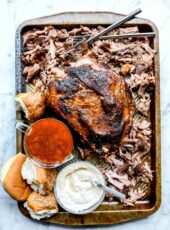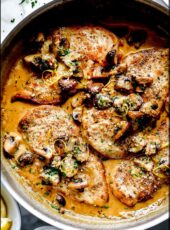This customizable Asian hot pot recipe is effortlessly prepared and ideal for serving when entertaining friends and family.
One cooking method that transcends various Asian cuisines is the hot pot. Whether Chinese, Japanese, Korean, Vietnamese, Thai, Mongolian, or others, the hot pot holds a prominent place.
Hot pot cooking resembles fondue in its communal nature. It encourages interaction and socializing. Its communal setup is just as suitable for entertaining guests as it is for a relaxed yet enjoyable dinner at home. Picture everyone gathering around the bubbling broth, vying for the best position to cook their favorite shrimp to perfection. With a hot pot, everyone has the freedom to select precisely what and how much they want to eat, as long as it fits into the pot.
Ingredients for Asian Hot Pot
An Asian hot pot comprises various adaptable components. Here’s the fundamental breakdown:
1. Broth (chicken, beef, seafood, or vegetable base)
2. Noodles or rice
3. Meats/seafood/protein
4. Vegetables
5. Leafy greens
6. Fresh herbs & aromatics (such as spices, curry paste, garlic, fresh ginger slices, chili oil, Thai basil, scallions, cilantro, lime)
7. Dipping sauces (like soy sauce, sesame oil, Thai peanut sauce)
Optimal Vegetables for Hot Pot
The possibilities are vast. Consider vegetables that harmonize with Asian flavors for a delightful experience.
Include:
– Leafy greens such as spinach, baby bok choy, morning glory, kale, watercress, Tatsoi, and finely chopped Napa cabbage.
– An array of mushrooms like shiitake, oyster, brown, or enoki.
– Bean sprouts.
– Varieties of onions like green onion, sliced red, or sweet yellow.
– Bell peppers or spicy peppers.
– Asparagus, snap peas, and green beans.
– Baby corn—a playful addition.
– Baby bamboo shoots, tomatoes, carrots, and small baby potatoes.
– Garnishes like Thai basil, cilantro, mint, and sliced limes.
Choosing Rice or Noodles for a Hot Pot
Versatility defines the hot pot. For your preferred carbohydrate, opt for noodles or steamed white rice. In our home, noodles often take center stage. We rotate between fresh egg noodles (resembling long strands of Asian-style fettuccine), toothsome ramen noodles, thicker rice noodles akin to those used in Pho, or delicate vermicelli noodles, as found in Vietnamese chicken curry noodle salad bowls. Whichever I choose, I cook the noodles while the broth simmers and serve them in a bowl alongside the rest of the ingredients.
Selecting Your Hot Pot Protein Options
When it comes to proteins for your hot pot, the choices are abundant:
– Very thinly sliced beef or pork is essential. I prefer buying pre-sliced cuts from my local Asian market, where they offer wafer-thin slices of wagyu that cook in about 30 seconds.
– If slicing the beef at home, opt for a high-grade, marbled cut like ribeye or short ribs. Firm it up in the freezer for 15-30 minutes before slicing it as thinly as possible. No need for seasoning or marinating the meat when boiling it in the hot pot (although it’s delightful when grilled!).
– Asian beef meatballs, often pre-cooked and available in the freezer section, come in various flavors, including intriguing seafood options.
– Tofu is versatile. While I adore fried tofu, packaged options work well too. Choose firm or extra firm tofu to withstand cooking with other ingredients if fried tofu isn’t your preference.
– Seafood choices like shrimp, crab, or fish elevate the hot pot experience. For crab or lobster, pre-cut the shells for easy meat extraction. Mussels, clams, and other crustaceans are popular, along with the classic fish cake. Mild white fish and scallops are excellent seafood additions.
– Eggs are a customary addition. Quail eggs are traditional, but for convenience, I prefer preparing soft, jammy ramen eggs to slice and add afterward for a tidier dining experience.
Hot Pot Broths
Variation 1: Asian Red Curry Hot Pot Broth
I highly recommend opting for two distinct broths—one mild and the other spicy or tailored for different ingredients like beef and vegetables or seafood. For our hot pot, I chose two contrasting broths. The first one features a simple beef broth infused with sliced sweet onion, Thai Kitchen red curry paste, and McCormick’s ground ginger and garlic powder directly from my spice rack. This recipe was inspired by the McCormick recipe website, following insights from the McCormick Flavor Forecast report.
Adjust the amount of red curry paste in the recipe below based on your preference for spiciness. A touch of additional lime juice can help balance the heat and enhance the flavors.
Variation 2: Thai Curry Hot Pot Broth
The second broth for our hot pot journey is adapted from my friend Ali’s Easy Thai Curry Hot Pot. It involves a coconut-based broth, reminiscent of the one used in my 5 Ingredient Thai Pumpkin Soup, sans the pumpkin.
I made slight modifications to Ali’s recipe by substituting chicken stock for vegetable stock and incorporating 2 tablespoons each of brown sugar and fish sauce, similar to the flavor profile in my Slow Cooker Thai Chicken Soup.
Essential Equipment for Hot Pot Cooking
The heart of hot pot dining lies in tableside cooking. You have a couple of options: the traditional divided pot for multiple broths or a simpler approach using a single broth with a deep-sided electric fry pan or an Instant Pot as a clever hack.
As someone who prepares this dish often, I invested in a stainless steel-divided electric hot pot. You can also discover hot pots featuring built-in grills at the base for grilling meats and seafood before adding them to the broth. Additionally, hot pots are available solely as warming vessels that can be placed on a butane heater or an electric burner.
Here’s what else you’ll need for your hot pot feast:
– Small serving bowls to allow diners to swiftly load their cooked food. Smaller bowls help maintain the broth’s heat and encourage continual cooking.
– Chopsticks and soup spoons for savoring and retrieving the cooking ingredients. Remember to designate separate chopsticks for cooking and eating to avoid contaminating the communal broth.
– Small strainers (one per diner) for fishing out ingredients or containing them while they cook.
– Ladles for serving the individual broth(s) to each diner.
In This Post
Red Curry Hot Pot Broth
Add more or less red curry paste to this beef stock-based broth depending on your desire for spiciness and add a squeeze of more lime to balance the heat and flavors.CourseMain CourseCuisineAsianKeywordAsian Hot PotPrep Time20Cook Time25Total Time45Servings4Calories69kcalIngredients
- 2 teaspoons vegetable oil
- 1 large sweet onion, thinly sliced
- 2 containers, 32 ounces each Kitchen Basics® Original Beef Stock, (8 cups)
- ¼ cup Thai Kitchen® Red Curry Paste
- 2 tablespoons reduced-sodium soy sauce
- 1 tablespoon packed light brown sugar
- 1 tablespoon McCormick® Garlic Powder
- 1 teaspoon McCormick® Ginger, ground
- 2 tablespoons lime juice
Instructions
Notes
Hot pot is best enjoyed right away, but if you have leftover broth you can certainly save it and reheat it the next day.Nutrition
Calories: 69kcal | Carbohydrates: 14g | Protein: 2g | Fat: 1g | Saturated Fat: 1g | Polyunsaturated Fat: 1g | Monounsaturated Fat: 1g | Sodium: 277mg | Potassium: 157mg | Fiber: 2g | Sugar: 8g | Vitamin A: 2334IU | Vitamin C: 7mg | Calcium: 44mg | Iron: 1mg











